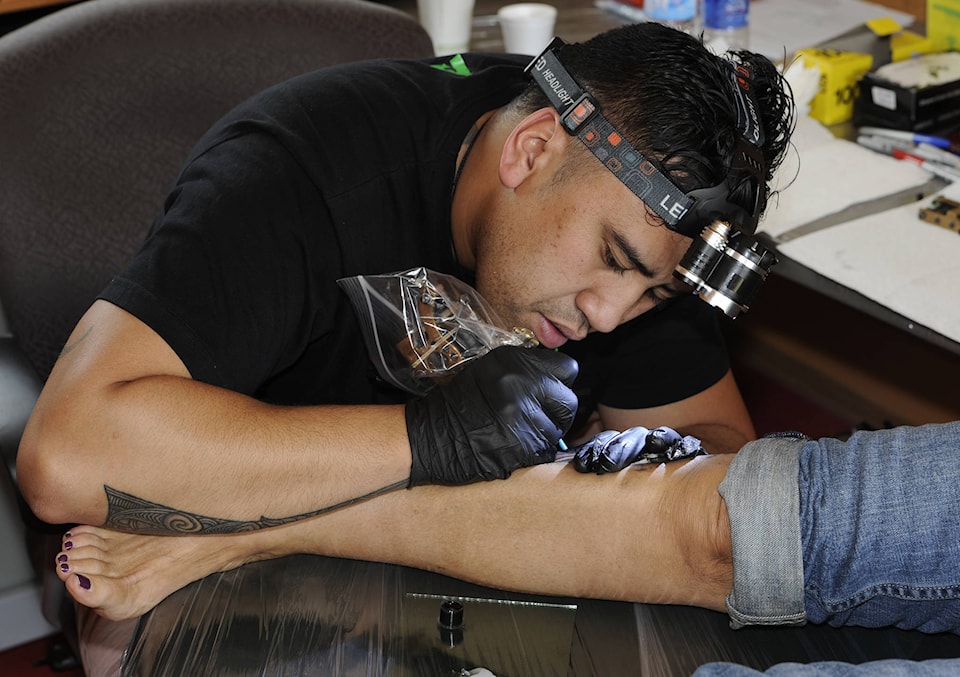Te Wehi Preston is sitting in a small wooden hut, his back bent at nearly 90 degrees, holding a tattoo machine in his right hand.
He squints at his latest work in progress, unaware of the frown forming on his forehead. Small beads of sweat start to form. It’s a hot day in Whitehorse, a rarity this summer. He wipes the sweat with his left hand, sitting up for a second before he bends over again. A womens skin is pink from being pricked by a needle a thousand times a minute. He places the machine, controlled by a pedal at his foot, back on her arm and the hut is filled with a buzzing noise that makes anybody who hasn’t gotten a tattoo before cringe.
I’ve been to a tattoo studio half a dozen times, always with a friend who was getting one. I’ve sat offering meagre words of encouragement, trying not to squirm as my friend sits there hour after hour, getting pricked and poked. But I never look away. I watch every step of the process, from the initial stencil that’s traced onto your skin to the wrapping of the tattoo to protect it from infection.
But watching Preston, something is different. There’s no template. No stencils. Not even papers with initial sketches. I ask the woman, Jennifer Younger, if she told him what design she wanted to get.
“No, I have no idea what it’s going to be. I’m just placing my trust in him,” she says.
The only reason I’ve haven’t got a tattoo yet is because I’m neurotic about the design I permanently engrave on my body. But Younger and the 20 others after her, are placing their trust in Preston, as he draws on their skin freehand with a tattoo machine. This isn’t normal. But then Preston isn’t a normal tattoo artist and this isn’t an ordinary tattoo.
Preston is a Māori tattoo artist who specializes in Tāmoko, the traditional body art of the Māori people of New Zealand, giving him the name tohunga tā moko (moko specialist).
He’s in Whitehorse for the Adäka Cultural Festival.
“Tā moko is not a tattoo for our people,” he says. “It is a way of life.”
Enthralled, I ask him to tell me everything and more.
“For a Māori person, the patterns and designs in a moko tie back through blood all the way back to the ancestors, to the ones who gave us this art form,” he says.
He tells me the genealogy of the art form can be traced back to Ruaumoko, god of earthquakes and volcanoes. He is the youngest son of Papatuanuku (earth mother) and Ranginui (sky father).
“Our creation story comes from the separation of the earth mother and sky father,” he says.
Papatuanuku and Ranginui were locked together in a tight embrace but were separated by Ruaumoko’s brother, Tāne, god of forests and birds. The brothers had gotten tired of living in the cramped darkness between their parents and wished to live in the light. When Tāne finally forced his parents apart, his other brother Tangaroa became god of the sea.
“The waves are Tangaroa’s children. He has millions of children that he sends out every day,” he says.
Tangaroa’s children are an inspiration for puhoro, a wave pattern often seen in a Tā moko. They signify speed and agility says Preston.
“It is to remind us as warriors to be light and nimble on our feet,” he says. Where you get the moko is also significant, Preston adds. Mokos in the area of your legs and feet, or kātete, tell the story of home and where you’re from.
“This could be patterns derived from mountains, land, food, trees, plants, anything to do with the environment where you’re from,” he says.
But then, what does a moko mean for a non-Māori person? Can a non-Māori person even get a moko?
“The name changes for a non-Māori person. It’s not called a moko, it’s called a kirituhi,” he says.
A kirituhi has the same markings and patterns as that of a moko, but it tells a different story.
“For non-Māori, since the ancestral roots don’t tie back directly to our gods, it instead depicts the person’s journey from their point of view,” he says.
Preston is almost done with Younger’s kirituhi. He’s using green ink to fill some deliberate gaps in the kirituhi. It looks beautiful, but my interest lies in the story it tells. He adds the last of the green dots, wipes the residual ink away with a wet cloth, takes a deep breath and looks at Younger.
“This particular piece is dedicated to your knowledge and craft,” he says focusing on Younger’s life as an Indigenous artist and mother. He explains that some patterns within the kirituhi are intricately designed to remind her to stay true to her customs and traditions. It touches on the need to pass on her knowledge to keep traditions alive. Three triangles represent her three children, reminding her of why she does what she does.
“Everything he said was so on point,” she tells me later.
As for me, I finally know what tattoo I’m getting.
Contact the Yukon News at editor@yukon-news.com
